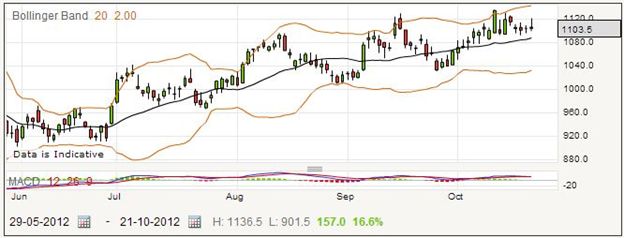Travis Perkins is in the construction sector, and presents good opportunities for spread betting due to the volatility that this sector experiences. It is a leading company in home improvement, and a major supplier to the building and construction market, which is regarded as one of the bellwethers of the economy.

This daily price chart shows that overall there is an uptrend in the stock price, and also demonstrates the volatility that can be traded for a profit.
As might be expected, Travis Perkins did poorly during the global economic crisis of 2008, and the shares went down to below 200p, from a previous high of around 1600p. So the current situation is that the shares have not fully recovered their value, which you might expect from the current economic climate in the UK.
Although Travis Perkins was only formed in 1988, following the combination of Travis & Arnold and Sandell Perkins, it actually has roots going back more than 200 years. At the end of the 18th century the Benjamin Ingram company, which specialized in construction carpentry, was formed, and after a merger to become Ingram Perkins, this subsequently became Sandell Perkins in 1970. This was listed on the London Stock Exchange in 1986, two years before the most recent merger.
Over the years Travis Perkins has taken over many other companies in the construction sector, including Wickes, Keyline Builders Merchants, City Plumbing Supplies, and many other smaller companies. Ranking high in the FTSE 250, Travis Perkins has more than 600 branches, employs about 16,000 people, and has an annual revenue of about £5 billion.
If you are considering spread trading on Travis Perkins, then you will see that the chart is particularly interesting, showing the price oscillating between the upper and lower Bollinger Bands. The cycle of the MACD provides a reasonable first approximation to where the price is within the constraints of the Bands.
Travis Perkins Rolling Daily: How to Spread Bet on Travis Perkins shares?
The chart shows that Travis Perkins is currently fairly predictable in its cycles, and presents a reasonable opportunity for profit with your spread betting. The current rolling daily price is 1101.2 – 1107.8. By way of example, assume that you think the price will go down in the near future, and choose to place a short or sell bet for £2.50 per point.
Suppose that the price falls until it reaches 1048.5 – 1055.1. You decide to close your winning bet and collect your profits. Your short bet was placed at the selling price of 1101.2, and you closed it at the buying price of 1055.1. Working out how many points you have gained, 1101.2 minus 1055.1 is 46.1 points. Multiplying this by your stake of £2.50 per point, your bet would be worth £115.25.
While that is what you’re hoping for, many times you will find that the price will not go the way that you expect, and you will be faced with closing your bet for a loss rather than hanging on in hope and watching your losses increase. Perhaps the price went up to 1143.8 – 1150.4, and you decided to cut your losses and close the trade. This time your bet closed at 1150.4, from the opening price of 1101.2, which means you lost 49.2 points. This loss would amount to £123.
This is a significant loss, perhaps because you could not watch the price all the time, and close the bet earlier. If this is the case, you should consider using a stoploss order which requires your spread betting provider to close the losing bet whether or not you are online. If you had used a stop loss order, you might find that your losing trade closed at 1130.1 – 1136.7. In this case with a starting price of 1101.2 and a closing price of 1136.7 you would have lost just 35.5 points. For your chosen size of stake, this would amount to £88.75.
Travis Perkins Futures Based Spread Bet
Taking a longer-term view of Travis Perkins stock price, you might decide that the price is going up over the next few months and choose to place a long bet. The price quote for the far quarter futures style bet is 1105.3 – 1119.3, and you choose to stake £5 per point.
In a few weeks or months, you might find that the price has gone up to 1183.4 – 1195.2, and decide that you will close the trade and collect your winnings. Your long bet was placed at 1119.3. You closed your bet at 1183.4. You have made 1183.4 minus 1119.3 points, or 64.1 points. If you multiply this by your stake of £5 per point, you will find that you have made £320.50.
On the other hand, this may be one of those trades which does not succeed, and you should expect your share of losers when spread betting. If the price drops down to 1068.2 – 1080.0, then you may decide to close the bet for a loss to avoid any further decline. The opening price was 1119.3, as before, and you closed the bet at 1068.2. This is a difference of 51.1 points, which for a wager of £5 per point amounts to a loss of £255.50.
Many traders decide to use a stop loss order to take them out of a losing trade if it reaches a certain level. The stoploss order is usually placed when you open the bet, and some spread betting providers even include it on the deal ticket so that you are less inclined to forget. With a stoploss order, you might find that this trade was closed at 1080.6 – 1092.3. The closing price is 1080.6, and the opening price was 1119.3. The difference between these is 38.7 points, which for your chosen stake amounts to £193.50.